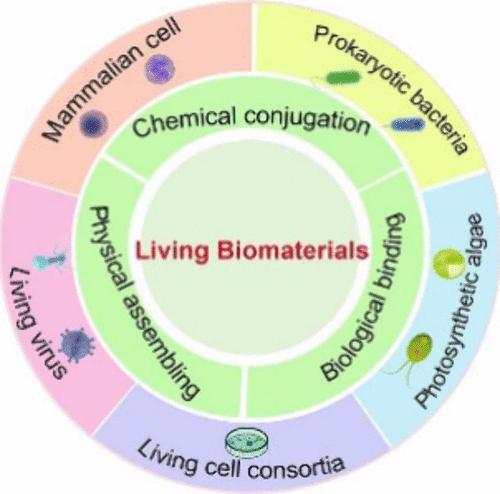当前位置:
X-MOL 学术
›
Acc. Mater. Res.
›
论文详情
Our official English website, www.x-mol.net, welcomes your
feedback! (Note: you will need to create a separate account there.)
Living Biomaterials: Fabrication Strategies and Biomedical Applications
Accounts of Materials Research ( IF 14.0 ) Pub Date : 2024-10-23 , DOI: 10.1021/accountsmr.4c00258 Qi-Wen Chen, Xian-Zheng Zhang
Accounts of Materials Research ( IF 14.0 ) Pub Date : 2024-10-23 , DOI: 10.1021/accountsmr.4c00258 Qi-Wen Chen, Xian-Zheng Zhang

|
Natural or bioengineered living organisms (including mammalian cells, bacteria, microalgaes, yeast, viruses, plant cells, and the multiple organism community) possess many intrinsic or artificial superiorities than the synthesized and inert biomaterials for application in many fields, especially biomedical applications. By leveraging the inherent or artificial therapeutic competences (e.g., disease chemotaxis, drugs production, intelligent delivery, immune activation and metabolic regulation), these living organisms have been developed as critical therapeutic formulations for biomedical applications to solve unmet medical needs. These living organisms are more intelligent, more easily available, more highly active, and more strongly curative than conventional inert formulations, such as inorganic nanocarriers, metal–organic chelating networks, polymeric nanovesicles and biomembrane biohybrids, etc. Nevertheless, nonspecific in vivo circulation, the diseased microenvironment-triggered inactivation, uncontrolled proliferation or colonization, unexpected side effects, and unsatisfactory therapeutic effect severely restricted their further research development and clinical approval. Living biomaterials, fabricated by integrating tailored functional materials with natural or bioengineered living organisms by chemical conjugation, physical assembly, and biological engineering strategies as well as advanced construction techniques, are rapidly developed to preserve or augment bioactivity and therapeutic properties of living organisms and even control their behaviors, decrease their biotoxicity, and impart them with new biofunctionalities, like stress resistance, bioactivity maintenance, safe trafficking, controllable proliferation and colonization, and evolved metabolism properties. These acquired capacities are especially beneficial to improve therapeutic potency and compliance, solve significant therapeutic restrictions, avoid biosafety questions, enhance therapeutic performances, and extend the boundaries of the fabricated living biomaterials on science research and practical biomedical applications. Additionally, the introduction of biocompatible and instructive functional materials, such as inorganic materials, synthetic polymers and polypeptides, functional proteins and enzymes, as well as biological component materials, can also promote the interaction of living biomaterials with the living body and provide feedback to further adapt the biofunctions of living organisms.
中文翻译:

生物材料:制造策略和生物医学应用
与合成和惰性生物材料相比,天然或生物工程生物体(包括哺乳动物细胞、细菌、微藻、酵母、病毒、植物细胞和多种生物体群落)具有许多内在或人工优势,可用于许多领域,尤其是生物医学应用。通过利用固有或人工的治疗能力(例如,疾病趋化性、药物生产、智能递送、免疫激活和代谢调节),这些生物体已被开发为生物医学应用的关键治疗制剂,以解决未满足的医疗需求。这些生物体比传统的惰性制剂(如无机纳米载体、金属-有机螯合网络、聚合物纳米囊泡和生物膜生物杂交剂等)更智能、更容易获得、活性更高、疗效更强。然而,非特异性体内循环、患病微环境触发的失活、不受控制的增殖或定植、意想不到的副作用和不满意的治疗效果严重限制了其进一步的研究开发和临床批准。 生物材料是通过化学共轭、物理组装和生物工程策略以及先进的构建技术将定制的功能材料与天然或生物工程生物体相结合而制造的,可以迅速发展以保存或增强生物体的生物活性和治疗特性,甚至控制它们的行为,降低它们的生物毒性,并赋予它们新的生物功能。 如抗逆性、生物活性维持、安全运输、可控增殖和定植以及进化的新陈代谢特性。这些获得的能力特别有利于提高治疗效力和依从性,解决重大的治疗限制,避免生物安全问题,提高治疗性能,并扩展人造生物材料在科学研究和实际生物医学应用中的界限。此外,引入生物相容性和指导性功能材料,如无机材料、合成聚合物和多肽、功能蛋白和酶,以及生物成分材料,也可以促进生物材料与生物体的相互作用,并提供反馈,以进一步适应生物体的生物功能。
更新日期:2024-10-25
中文翻译:

生物材料:制造策略和生物医学应用
与合成和惰性生物材料相比,天然或生物工程生物体(包括哺乳动物细胞、细菌、微藻、酵母、病毒、植物细胞和多种生物体群落)具有许多内在或人工优势,可用于许多领域,尤其是生物医学应用。通过利用固有或人工的治疗能力(例如,疾病趋化性、药物生产、智能递送、免疫激活和代谢调节),这些生物体已被开发为生物医学应用的关键治疗制剂,以解决未满足的医疗需求。这些生物体比传统的惰性制剂(如无机纳米载体、金属-有机螯合网络、聚合物纳米囊泡和生物膜生物杂交剂等)更智能、更容易获得、活性更高、疗效更强。然而,非特异性体内循环、患病微环境触发的失活、不受控制的增殖或定植、意想不到的副作用和不满意的治疗效果严重限制了其进一步的研究开发和临床批准。 生物材料是通过化学共轭、物理组装和生物工程策略以及先进的构建技术将定制的功能材料与天然或生物工程生物体相结合而制造的,可以迅速发展以保存或增强生物体的生物活性和治疗特性,甚至控制它们的行为,降低它们的生物毒性,并赋予它们新的生物功能。 如抗逆性、生物活性维持、安全运输、可控增殖和定植以及进化的新陈代谢特性。这些获得的能力特别有利于提高治疗效力和依从性,解决重大的治疗限制,避免生物安全问题,提高治疗性能,并扩展人造生物材料在科学研究和实际生物医学应用中的界限。此外,引入生物相容性和指导性功能材料,如无机材料、合成聚合物和多肽、功能蛋白和酶,以及生物成分材料,也可以促进生物材料与生物体的相互作用,并提供反馈,以进一步适应生物体的生物功能。






























 京公网安备 11010802027423号
京公网安备 11010802027423号